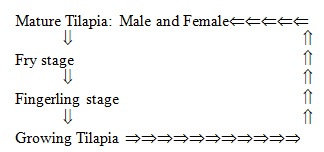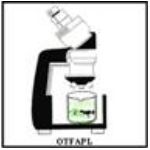Topics Covered in this Section
19.3.2 Factors Affecting Tilapia Production
19.3.3 An Intensive Animal Production System for the Tilapia
[I] The Objectives of the Production System or Model
III] The Physiological States for the Production Flow
[IV] Performance Coefficients or Growth Parameters
[VI] Animal Specific Needs as influenced by the Factors affecting animal Production Needs
[VII] Animal Behavior and Sociology
[VIII] Design of the Physical Environment Required
[IX] Management Routines Required
[XI] Output Expectations of the Model/Production Process Flow
AGLS 6502 Lecture 19.3 - The Tilapia
1. to be able to describe the animal production factors affecting the Tilapia;
2. to understand the animal production coefficients and parameters for the Tilapia and to see how this would relate to production of this species in captivity;
3. to become familiar with an approach to the intensification of Tilapia production.
back to top
19.3.2 Factors Affecting Tilapia Production
Water Quality:
Adequate Supplementary Nutrition:
30-35% CP of which about half must be of fish origin
Predation:
Stocking Density:
Readings:
You could refer to Hanley (undated) for further information.
19.3.3 An Intensive Animal Production System for the Tilapia
Considerations for Species Production Modeling: The Species: Oreochromis niloticus; Tilapia nilotica and T. mossambica
[I] The Objectives of the Production System or Model
(1) To develop and manage an intensive Tilapia breeding colony.
(2) To grow out the Tilapia to market weight for sale as fresh water fish.

[III] The Physiological States for the Production Flow
1] Mature Tilapia: Male and Female
2] Eggs (the eggs are fertilized in the mouth of the Female)
3] Fry
4] Fingerling [Sexual differentiation takes place at about 6 to 8 weeks]
5] Growing
[IV] Performance Coefficients or Growth Parameters
Guide to Red Hybrid Tilapia Growth
Age of Fish (weeks) |
Approximate |
Number of |
4 |
1 |
450 |
[Source: Hanley (Undated)]
back to top-Brood Pond: 1 acre Brood Pond / 20 Acres Production Ponds
-Stocked with sexually mature adults > 100g [4 animals to the LB]
- stocking rate 4000 to 5000/ acre
- Sex Ratio -1 male: 2 Female
- Fry Production begins at about 3 weeks
- remove frys every 7 to 14 days
- average female produces 100 frys per month.
[You could consult Hanley (undated) for further details].
back to top[VI] Animal Specific Needs as influenced by the Factors Affecting animal Production Needs
a. Housing
Read Ramnarine (1989) for details on pond design.
b. Nutrition and Feeding
Formulated Fish feed with 28 to 30% CP;
Animals fed once or twice per day feeding at a rate of 2 to 10% body weight [refer to Hanley (Undated)] .
c.Health and Disease Control
Refer to Hanley (Undated).
back to top
d.
Reproductive Management
Production ponds must be mono sexed. Refer to Hanley (Undated).
[VII] Animal Behavior and Sociology
Ponds should be stocked with similar sized animals to avoid stress due to competition.
[VIII] Design of the Physical Environment Required
1] Breeding / Brood Pond
2] Fry Ponds
3] Grow out Ponds
4] Sorting / Holding Ponds or Tanks
5] Aeration System
6] Drainage and Water Control System
7] Water Supply System
[IX] Management Routines Required
- Daily
- feeding
- aeration
- Weekly
- fry removal from brood ponds
- Monthly
- animal size monitoring
- Seasonally
- pond maintenance and repair
- Annually
- Feed
- Labour
[XI] Output Expectations of the Model/ Production Process Flow
back to top
Hanley, F. (Undated): A Guide to the Farming of Tilapia, Master Blend Feeds Ltd., Kingston, Jamaica.
Helpful Links, Photos, Videos and Multimedia
